Then we moved to the demo section, starting indeed with PowerVR MBX. On the previous page I talked about the most exciting thing on the mobile market? Well PowerVR MBX is it. In fact it is there (in alpha phase) and it was working.
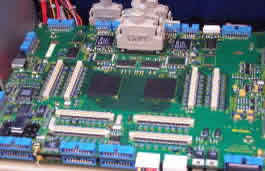 | 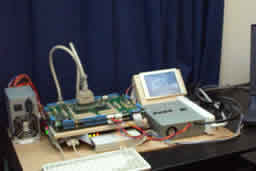 |
So what is PowerVR MBX?
(Taken from the Cebit press release, which can be found here)
"PowerVR MBX is a complete 2D/3D graphics solution for future wireless multimedia devices optimised for low power and high performance. The demonstration platform consists of an ARM 920 processor with PowerVR MBX in FPGA technology, with a 320x240 LCD display, and clearly demonstrates the high performance and market leading image quality of an ARM / PowerVR Technologies 2D/3D graphics solution. "
The images shown above are indeed the PowerVR MBX board on top of another board, which hosted the ARM 920 processor. The left processor is the MBX cpu, the right one is an T+L chip. The silicon ran at a much lower speed as when it's going to be produced. First we got to see a dragon, fully bump-mapped on the 320*240 screen. It was nice to see, but then we moved to the vase demo running at 160*120, fully anti-aliased (4x FSAA). I have made some shots on my Kyro II board, so you get the impression what the demo was
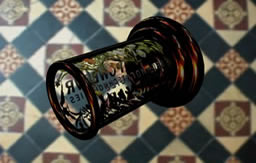 | 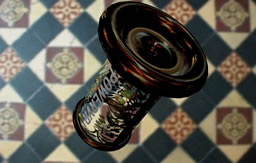 |
Can you imagine this running on your PDA? Well it is possible on the PowerVR MBX platform. But then David showed Tomb Raider running on the MBX. Framerate, David said, is already higher as on the original Sony Playstation I version. ... Tomb Raider on a PDA.
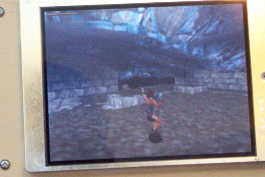
This image by coutesy of Kyro World
Pretty cool stuff, combine this with broadband on the mobile platform and we have true mobile gaming. On these small screens (320*240) FSAA is a feature which is important and gives direct results. Advanced filtering methods are really important on low resolutions, PowerVR MBX shows great promise for future gaming and applications. PowerVR's low power consumption makes it ideal for mobile solutions (like notebooks, PDA's ect). I'm very interested in PowerVR MBX and will follow it closely, mainly also for my work.
The Kyro II demos were up next. There were the default PowerVR demos and one which is already being used for quite a while now. This demo represents a space ship flying across a huge landscape, to illustrate the PowerVR's tile based rendering technique also can process huge numbers of polygons. Next (also a highlight this Cebit) David showed off the demo which is used by developers; Unreal II. This ie the demo Anand used in his benchmarks, but this demo does not reflect the actual Unreal II game. It is a presentation on how many polygons roughly are going to be used in the UT II engine, it is a demo and should be treated as such. I had never seen Unreal II in action, but whoa this looks good! The frame-rate (David was not allowed to put the frame-rate counter on) was good. I suspect somewhere between 50 - 60FPS.
I would like to thank David Harold and Img Tech for his time.
